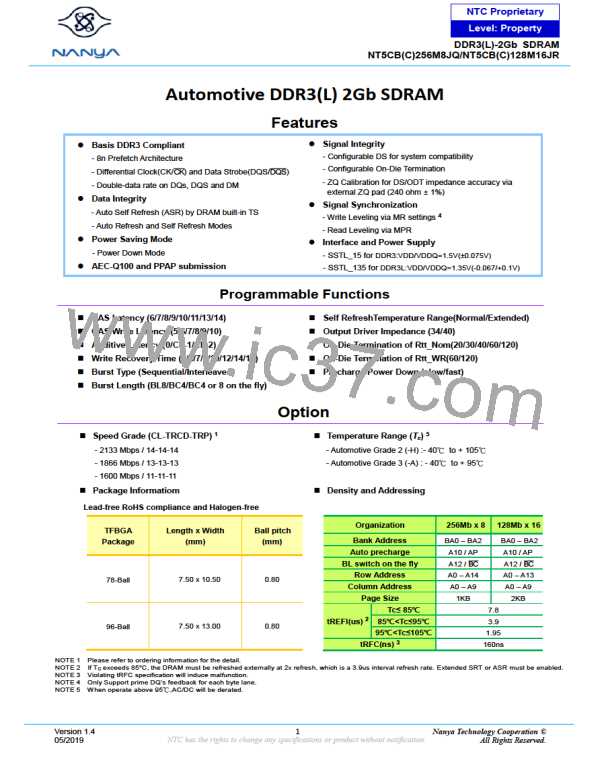NTC Proprietary
Level: Property
DDR3(L)-2Gb SDRAM
NT5CB(C)256M8JQ/NT5CB(C)128M16JR
ZQ Calibration Commands
ZQ Calibration Description
ZQ Calibration command is used to calibrate DRAM Ron and ODT values. DDR3(L) SDRAM needs longer time to calibrate
output driver and on-die termination circuits at initialization and relatively smaller time to perform periodic calibrations.
ZQCL command is used to perform the initial calibration during power-up initialization sequence. This command may be
issued at any time by the controller depending on the system environment. ZQCL command triggers the calibration engine
inside the DRAM and once calibration is achieved the calibrated values are transferred from calibration engine to DRAM IO
which gets reflected as updated output driver and on-die termination values.
The first ZQCL command issued after reset is allowed a timing period of tZQinit to perform the full calibration and the transfer
of values. All other ZQCL commands except the first ZQCL command issued after RESET is allowed a timing period of
tZQoper.
ZQCS command is used to perform periodic calibrations to account for voltage and temperature variations. A shorter timing
window is provided to perform the calibration and transfer of values as defined by timing parameter tZQCS. One ZQCS
command can effectively correct a minimum of 0.5 % (ZQ Correction) of RON and RTT impedance error within 64 nCK for
all speed bins assuming the maximum sensitivities specified in the ‘Output Driver Voltage and Temperature Sensitivity’ and
‘ODT Voltage and Temperature Sensitivity’ tables. The appropriate interval between ZQCS commands can be determined
from these tables and other application-specific parameters. One method for calculating the interval between ZQCS
commands, given the temperature (Tdriftrate) and voltage (Vdriftrate) drift rates that the SDRAM is subject to in the
application, is illustrated. The interval could be defined by the following formula:
where TSens = max(dRTTdT, dRONdTM) and VSens = max(dRTTdV, dRONdVM) define the SDRAM temperature and
voltage sensitivities.
For example, if TSens = 1.5% / oC, VSens = 0.15% / mV, Tdriftrate = 1 oC / sec and Vdriftrate = 15 mV / sec, then the
interval between ZQCS commands is calculated as:
No other activities should be performed on the DRAM channel by the controller for the duration of tZQinit, tZQoper, or tZQCS.
The quiet time on the DRAM channel allows calibration of output driver and on-die termination values. Once DRAM
calibration is achieved, the DRAM should disable ZQ current consumption path to reduce power.
All banks must be precharged and tRP met before ZQCL or ZQCS commands are issued by the controller.
ZQ calibration commands can also be issued in parallel to DLL lock time when coming out of self refresh. Upon self-refresh
exit, DDR3(L) SDRAM will not perform an IO calibration without an explicit ZQ calibration command. The earliest possible
time for ZQ Calibration command (short or long) after self refresh exit is tXS.
In systems that share the ZQ resistor between devices, the controller must not allow any overlap of tZQoper, tZQinit, or
tZQCS between ranks.
Version 1.4
05/2019
81
Nanya Technology Cooperation ©
All Rights Reserved.

 NANYA [ Nanya Technology Corporation. ]
NANYA [ Nanya Technology Corporation. ]